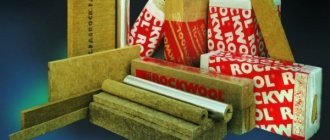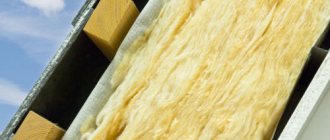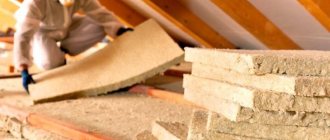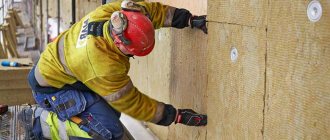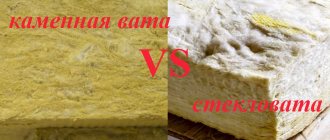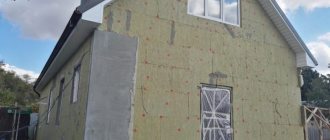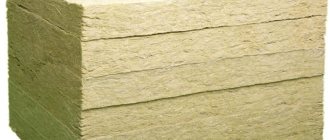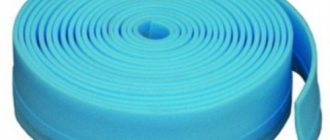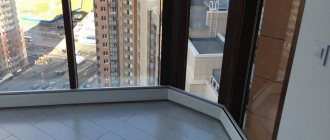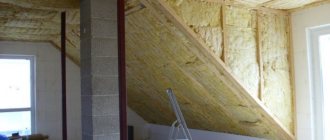The rating of soundproofing materials for an apartment presented in this article will help you choose the best option for soundproofing walls specifically for your specific case. But if you think that I will tell you one of the best or most popular soundproofing materials, then I will have to disappoint you a little. The fact is that there is no material that is ideal for different situations. Much depends on the type of penetrating noise, its intensity, the design of the walls, and the permissible thickness of the soundproofing material. Based on this, one or another material is selected.
A little about what kind of noise there is?
Everyone knows that in Khrushchev buildings you can hear the conversation of neighbors living several floors above. But this also happens in modern houses. In monolithic buildings, sound is transmitted through vibration of walls and ceilings, cracks, crevices and gaps in the structure. Therefore, it is advisable to think about sound insulation even before you start repairs.
Sounds enter our homes in a variety of ways. There are several types of noise:
- a drill drilling into a wall, falling objects, steps coming from above, moving furniture - this is a manifestation of impact noise ;
- a dog barking, a child crying, neighbors playing music, loud conversations – this is airborne noise.
Sounds of the first category penetrate through the vibration of house structures, while sounds of the second category are heard through cracks and cracks. Before choosing a soundproofing material, you need to decide which noise you will eliminate. In both cases, stone wool slabs are the best choice.
Rating of the best materials for soundproofing walls
| Nomination | place | Name of product | rating |
| The best materials for soundproofing walls | 1 | SoundGuard EcoZvukoIzol | 5.0 |
| 2 | TECSOUND FT-75 | 4.9 | |
| 3 | ZIPS-III-Ultra | 4.8 | |
| 4 | Schumanet-ECO | 4.7 | |
| 5 | SoundGuard isocover | 4.6 | |
| 6 | Soundline-dB | 4.5 | |
| 7 | Wicanders Dekwall Melville | 4.4 | |
| 8 | StopSound Eco | 4.3 | |
| 9 | SoundGuard Membrane | 4.2 | |
| 10 | Knauf AcoustiKnauf | 4.1 | |
| 11 | Rockwool Acoustic Butts about Ultrathin 27x600x1000 mm | 4.0 | |
| 12 | TERMOZUKOIZOL | 4.0 |
Stone or mineral wool - is there a difference?
Many people confuse and substitute the concepts of stone and mineral wool. Some people think that this is one and the same thing, while others by mineral wool mean glass wool. In general, complete chaos and confusion. Let's dot all the i's together.
- Mineral wool is the general name for thermal insulating fibrous materials that are obtained from molten rocks, glass or slag.
- Mineral wool is divided into several types:
- stone or basalt - made from rock that is crushed, heated very much, and subsequently melted, after which it can be used to create slabs, mats and rolls. Since basalt is a hard rock, essentially a stone, the second name for basalt wool is stone;
- glass wool - produced from waste from the glass industry;
- slag wool - made from waste from the metallurgical industry (blast furnace slag).
- Comparing mineral wool and stone wool is like comparing trees and birch.
Glass wool absorbs moisture, as a result of which it loses its positive qualities. This does not happen with stone wool. The material has low hygroscopicity, and its noise-absorbing properties are not lost over many years. Slag wool and ecowool are also used, but in terms of performance they are inferior to basalt wool.
Please note that we are talking specifically about sound-absorbing properties - stone wool is not a sound-proofing material. But due to noise absorption, the room becomes quieter.
Acoustic mineral wool mats
Mineral wool mat is a material with increased sound insulation and thermal insulation. The panels can be lined on one or both sides with fiberglass or metal mesh. Made from non-flammable, environmentally friendly materials.
Mineral wool is based on glass, sand, metallurgical slag, and rocks.
Production is carried out in stages:
- All components in a certain proportion are poured into melting furnaces with a temperature of 1.5 thousand degrees. When melted, a liquid mass is formed.
- Then, using air blowing, fiber formation occurs. They can be horizontal, vertical or randomly directed.
- The fibers are bonded together by adding phenol-aldehyde resins.
- Next comes the cutting and formation of rolls, slabs or mineral wool.
Advantages and disadvantages of stone wool
Stone mineral wool is an inorganic fibrous material, the raw materials for which are various rocks: basalt, gabbro, diabase. In English it is literally called "mountain wool". Indeed, in appearance the material is similar to tangled wool fibers.
The material production technology is as follows. The crushed stone is melted in a furnace at a temperature of 1500°C to a liquid state. Then, in a centrifuge, under the influence of air currents, the finest fibers are formed. Individual fibers are connected with a special binder, to which a water repellent is added for moisture resistance. And only after heat treatment, the resulting “carpet” is cut into pieces and packaged.
Thanks to this base, stone wool has excellent performance and strength characteristics. Among the main advantages of the material:
- reliable heat and noise insulation. The fibrous structure absorbs sound up to 50 dB or more. At the same time, stone wool is one of the most effective insulation materials, i.e. you can kill two birds with one stone;
- durability;
- non-flammability. The basis of the material is stone, which melts at very high temperatures, so cotton wool is not afraid of fire, in case of fire it does not burn or melt;
- water-repellent properties;
- high tensile strength, especially in comparison with other soundproofing materials;
- resistance to chemically active substances;
- the material is not afraid of rodents, fungi and bacteria do not appear on it. Ultraviolet rays and temperature changes do not affect it;
- cotton wool is not able to absorb moisture. At the same time, steam passes through it without any obstacles - this is a very important property. Thanks to good vapor permeability, excess moisture and condensation evaporate and are removed from surfaces for which they are harmful;
- relative ease of installation.
critical drawback - stone wool slabs are quite brittle, so you should be extremely careful when transporting them.
Soundproofing walls: Schumanet vs Rockwool/Ursa
Solace wrote: I'm going to soundproof a wall - 50mm tin profile, sound insulation inside, on top of gypsum plasterboard/gypsum plasterboard (also unclear which is better) Question 1: How much more is the sound insulation of Schumanet than ordinary mineral wool? There was a similar topic on the forum, but it all boiled down to a comparison of harmfulness, and not a word about, in fact, sound insulation. If the difference is a couple of percent, then there is no point in overpaying.
Mineral wool is not a soundproofing material, but a sound-absorbing one. Acoustic engineer Andrey Smirnov in the publication “EFFICIENT SOUND INSULATION. BASIC RULES" explains how it works:
- Always dampen air pockets in double fencing and frame partitions. Even if both sides of the partition are mechanically decoupled, there is an elastic connection across the air gap. An oscillatory “mass-spring-mass” (MSM) system appears with its own resonant frequency, at which a decrease in the sound insulation of the fence is observed. The impact of this undesirable phenomenon can be significantly reduced by filling the air gap with special acoustic mineral wool (not random insulation!). This leads to a decrease in the resonant frequency of the MMM system and an increase in sound insulation at the low frequencies. If the task is to isolate only household noise (medium frequencies), then in order to save money, you can fill the air gap with acoustic mineral wool by 50-60%.
In his other publication “Soundproofing. Typical mistakes and misconceptions" contains the following data:
**Myth No. 5: The use of mineral or glass wool mats in frame partitions is sufficient to ensure high sound insulation between rooms
Facts: Special sound-absorbing slabs made of acoustic mineral wool provide an increase in the sound insulation of frame partitions, depending on their design, by 5-8 dB**. The use of arbitrary insulation materials in soundproofing structures leads to a much smaller effect or does not have any effect on sound insulation at all.
Advice: To increase the sound insulation of enclosing structures, it is strongly recommended to use special slabs made of acoustic mineral wool due to its high sound absorption rates. But acoustic mineral wool must be used in combination with soundproofing methods, such as the construction of massive and/or acoustically decoupled enclosing structures, the use of special soundproofing fasteners, etc.
Decibels, of course, are not percentages - percentages are not suitable because... The dependence is logarithmic, but the efficiency can be represented as follows:
Psychologists have found that a person perceives a decrease in sound pressure by 10 dB as a halving of the volume. Those. If the fence has a sound insulation of 10 dB, the penetrating noise will be perceived as twice as quiet. A fence with 20 dB of sound insulation is perceived as a decrease in sound pressure by 4 times (twice 10 dB is 2 times and 2 times again = 2*2). A fence with 30 dB of sound insulation is perceived as a reduction in sound pressure by 8 times (three times 10 dB is 2*2*2). A fence with 40 dB of sound insulation is perceived as a reduction in sound pressure by 16 times (four times 10 dB is 2*2*2*2).
This is more/less than the level of sound insulation of inter-apartment partitions, which actually exists in our houses: for example, the calculated SI index for a partition made of foam concrete (400) 20 cm - 43 dB will actually be lower.
Such inter-apartment partitions are now being built in most new buildings; through them you can hear not only the TV and vacuum cleaner, but also ordinary conversation.
Now, soundproofing cladding is 15-20 dB of additional sound insulation, bringing the home to the level of comfort (55-60 dB ZI).
A fence with 60 dB of sound insulation is perceived as a reduction in sound pressure by 64 times (six times 10 dB is 2*2*2*2*2*2).
We fill the space with random insulation instead of acoustic wool and reduce the HI index by 5-8 dB.
In other words, we spend money on everything else:
[*]vibration decoupling of the frame; [*]two layers of sheathing; [*]sealant; [*]and... we save on cotton wool;
and instead of 15-20 dB we get about 9-12 dB of additional sound insulation (and the reduction is due to the low-frequency range).
This, in turn, means that instead of reducing the volume level by ear by 64 times, we get only half - 32 times.
PS Just about the complicated stuff:
Solace wrote: Question 2: I remember that in the past, when constructing audio speakers, they used two materials for sound insulation - something like thick rubber, and a very soft hollow buffer material. So, what else would go well with mineral wool in terms of expanding the range of suppressed frequencies? Something thin, up to a centimeter, are there such materials?
Solace, analogies between enclosing structures and columns are not entirely appropriate, because... in the speakers, 18mm thick chipboard is used, but here we are talking about a much denser material with a thickness of 100-200mm, just as the automotive principle of sound insulation (vibration damping), suitable for thin metal plates, is not suitable.
Let's return to the fences: the GI index is an integrated indicator for a certain frequency range. If we look at the frequencies, we will see that the sound insulation of a plasterboard structure is worse in the low frequency range than the sound insulation of a similar brick structure (see graph).
Acoustic wool with a density of 65 kg/m3 has high sound absorption precisely at low frequencies, which contributes to the index in the end.
I used the shift in the range of sound absorption by cotton wool to the region of medium and high frequencies through the use of fiberglass acoustic boards because... I wanted to see their “behavior” at low frequencies without the support of sound-absorbing material.
In other words, IHMO - in life you need to pay maximum attention to the low ones, because... Sound insulation at medium and high levels for plasterboard structures is already good.
Acoustic glass wool with good sound absorption at medium and high levels is best used in sound-absorbing structures to correct room acoustics if the goal is to “cut off” medium or high levels. And for bass traps, you again need dense basalt wool with maximum sound absorption indices at low levels.
Solace wrote: And a separate question about soundproofing the floor. I'm going to lay parquet (scraped and varnished solid), at Leroy the manager suggested putting a 5mm sheet of cork under it. Those. plywood is sewn onto the screed (already made) in 500x500mm squares, cork is glued on top, and parquet is placed on top of it. Crap? I read somewhere here that the cork is only placed under the laminate.
The cork will only help against impact noise; it is better to put it under the plywood, and glue the parquet onto the plywood. Take plywood at least 22 mm, otherwise the floor will turn out echoing and not comfortable.
Density of stone wool
Depending on the density, stone wool is divided into the following types:
- lightweight - this type is most suitable for organizing sound insulation, dampening vibrations and airborne noise. The optimal density for effective sound absorption is 50-80 kg/m3. Alas, the strength of such a material is not very high;
- rigid has a density of more than 90 kg/m3, can withstand some loads, is more suitable for insulation, is used in the construction of ventilated facades, and also as a heat insulator under screed;
- technical has a density of about 200 kg/m3, can withstand heavy loads, and is used in the construction of engineering structures.
Soundproofing membranes
The same membranes Soundproof VEM are often used in combination with other materials. However, it can also be used as an independent sound insulator, but you should not count on high efficiency.
Advantages:
- High density and thinness;
- Fairly good protection from extraneous sounds;
- Health safety (if argonite is used);
- Flexible for easy installation.
It is quite difficult to choose something from such a variety of materials offered in construction stores. Therefore, it is worth considering the most popular soundproofing materials, which have repeatedly proven their effectiveness.
Stone wool installation options
Depending on your goals and the type of noise you want to get rid of, stone wool can be installed as follows:
- from the outer surface of the wall;
- on the inside of the walls and ceiling, well hidden under drywall;
- inside frame walls;
- insulation of pipelines and engineering structures that are a source of noise and vibration;
- under the roofing material.
Stone wool is available in the form of mats and slabs. If you consider that for sound insulation you need low-density cotton wool, then it is better to take mats - it will be easier to work with them. In addition, the slabs tend to crumble, so it is better to additionally use a layer of vapor barrier.
The article was written for the site.
Tags:Soundproofing
How to choose
What is better for sound insulation, polystyrene foam or mineral wool? The first is an excellent insulation, but a poor sound insulator. Cotton wool allows you to simultaneously protect the apartment from noise and insulate it.
Before purchasing, it is important to choose the right model correctly.
- Density is the main parameter of the material. It affects its ability to protect against noise, as well as its cost. The larger it is, the higher the price.
- For irregularly shaped structures, soft wool is suitable. It will be easier to install.
- To insulate a room, choose an insulator with a random fiber structure. It contains more air layers, which has a positive effect on its thermal insulation properties.
- For rooms with high humidity levels, you need to select a material with low vapor permeability. According to this indicator, stone-based mineral wool wins.
When purchasing, you should choose among reputable brands: KNAUF Acoustic, URSA or Penoplex.

